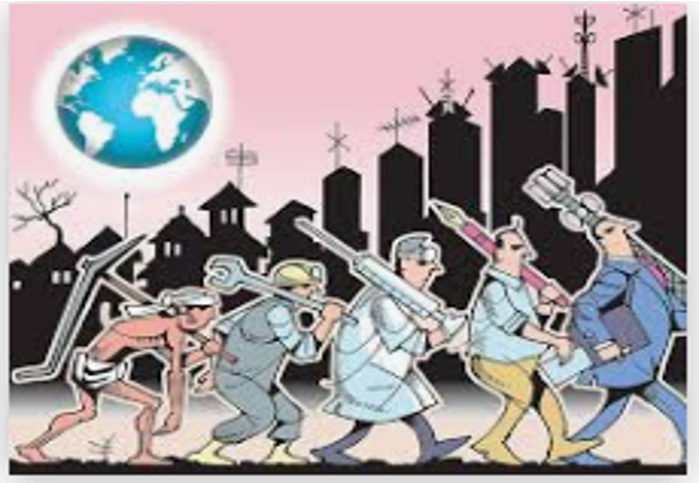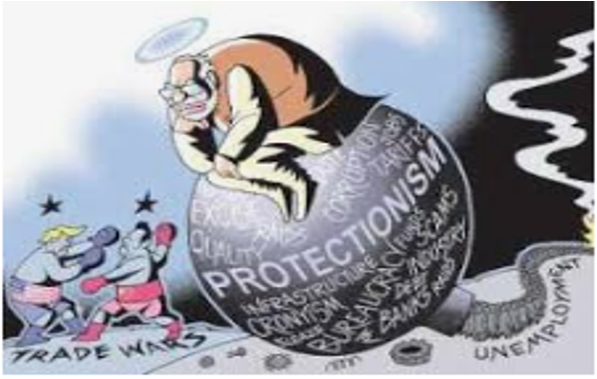
Atmanirbharta is a plan to be followed before the 1970s when the world was a huge place and global interconnectedness was null and void. Till the 1990s, the world had starting connecting and new form of economic order was being establishing the world. International markets were increasing, imports and exports were rising in every country. That was a period which had soon demanded the need for connected economies and supportive economic world order. Different countries produced different goods on the basis of the type of resource available and the skill sets of its majority population. The idea of globalisation and international trade are based on David Ricardo and Adam Smith’s theories. As the whole world had become interconnected, new opportunities grew for businesses to grow, new industries to rise and underdeveloped and developing countries to develop and become stable economies. A new world order has been established which is now impossible to break and is stupid if someone tries to.
India is a developing country and has many unique challenges that it faces on its path to become a superpower. Some of these are the ever increasing population, income inequality, thrashing economy, political instability and corruption, influence of caste religion, and social backgrounds that are the complete hindrance to the growth of this young nation. Only one solution is existed to overcome this challenge, globalisation. People associate globalisation as the repetition of the BRITISH RAJ. Children are told to support such a view in the name of fake nationalism and flawed Patriotism. Global markets provide Indian businesses the opportunity to become MNCs themselves. Global interconnectedness induces exchange of commodities, cultures, new services, industries, and JOB OPPORTUNITIES. If a country is not interconnected, then it will not be able to develop because then that country’s policies and practices will be based on certain biases and will lack the spirit of change. Basically, it take the form of a conservative protectionist economy instead of a liberal and developing economy. People and even the government tries to compare with China but if anyone does so then he or she is a stupid. The Chinese government and its policies are at times unethical. The reason for China‘s growth is there culture of strict discipline. Moreover, their government engages in currency and market interference that allows for the falling of prices of Chinese goods causing them to flood markets all around the world and this interference is wrong as said by many economists. Even still, another factor is the education system of China and the country’s determination to bring revolution and innovate. Take for example Shenzhen in China. Indian economy cannot survive on its own. India does not follow the CULTURE of strict discipline. Life is different around here and our cultural values have defined the structure of this economy but using those cultural values to shatter the economy is a blunder. India imposes one of the highest tariffs on import of different foreign goods. Mercantilist ideology is quite prevalent in India which is dangerous because it evidently shapes our economic policies because this assumption that exports are important and trade deficits are bad causes a lot of Indians (Highly EDUCATED POLITICIANS especially) to think of themselves as an economist capable enough to comment on government measures. Presently, we are living in trying times and are undergoing a lot of sufferings and in the dire moments, the backbone of any economy is the support from global supply chain. Unemployment has already shooting the graphs, millions of jobs are being lost, government policies are already being too irrational to be true, and at such a time, providing and gaining support from other economies in the form of foreign investments in an inevitable requirement. We need to reduce income inequalities, support the local businessmen and enable reestablishment of the Global as well as Domestic supply chain.
India is too backward at various industrial and market frontiers which is a dread for our economy. For growth, development, employment, survival, we need to build our country on the foundation of new opportunities and innovation. A globally interconnected and open economy is a must. Imports allow public to avail more and more kinds of services. New services, income growth (in accordance to inflation rates) gives rise to increased public investment and spending and the backbone of Indian economy today is middle class market investment and expenditure. Atmanirbharta is a flawed idea to be promoted in this era. It is equal to what a small and poor farmer does: “PRODUCTION FOR SELF CONSUMPTION”.


Till 1990s, we were an inward economy with the hopes of becoming a self-reliant “Atmanirbhar” country and we have failed at it immensely. The pace of development was very slow in all the structural and foundational sectors of the economy. Irrational policies to support “LOCAL” and domestic supply chain had hit us hard and that same mechanism is being seen repeated in our country as we see are GDP being contracted by 23.9%, jobs being lost, industries shutting down, services being reduced, lack of opportunities looming over our country as if our doom has arrived. We live an era of global dependence and interconnectedness, Restrictions on an economy and promotion of an idea like Atmanirbharta will crumble our already shattered economy under the pressures of high end trade wars. From poorest of Africa to the behemoth of development in USA, China and Europe, innovation and development anywhere is necessary as it serves us the opportunity to improvise, optimise and develop further. Another important factor these days is the increasing importance being given to reciprocity of trade all over the world. If we introduce quotas and tariffs, other countries will find it difficult to trade with us. Now even though our imports would reduce but as a result of that the market for our domestic goods will also shrink. In fact now the government itself is restricting exports of domestic produce which is a foolish step as it would lead to our domestic markets being flooded with goods leading to sharp decline in costs of production and product with simultaneous and uncontrolled inflation (Indian currency is continuously falling) leading to meagre revenue generation the consequence of which is a harsh downfall of value of the services generated in our country drowning us into an economic deflation and ultimately our already sick domestic supply chain and markets would collapse (India's exports shrank by 36.47 per cent, recovering significantly from a 60 per cent contraction in the previous month, according to the ministry of commerce. Exports in May 2020 were USD 19.05 billion, compared to USD 29.99 billion in May 2019, and USD 10.36 billion in April 2020). On the other hand if our economy is open and people are encouraged to invest on both foreign and domestic goods, employment, expenditure, investment, innovation, new opportunities and technological development would increase giving our country a steady economic rise.
To achieve economic growth, we need to shift our goals and trends. A shift from production economy to investment based economy is necessary. India is a resource rich country with ideal climatic conditions, so development of a production economy is a necessity as well as a smart choice but for that to happen what we need is a properly planned labour and work force distribution which is not happening under “Atmanirbharta”. If we promote Atmanirbharta, instead of investment, most of our middle class population will participate in production and manufacture which will cause a sudden rise in a sudden increase in workforce accumulation. Accumulation of resources and human capital is disastrous as it leads to the slowdown and lack of multi domain development which is what our country needs the most today. Clear example is the tax evasion for big corporates in the hopes of investment, but instead it turned out to be a huge fiscal deficit with no significant direct or indirect revenue generation (An expected net tax shortfall of about Rs.2.1 lakh crore. HSBC sees an even bigger miss. It expects net tax collection to fall short of the budget estimates by Rs.2.7 lakh crore. HDFC Bank Ltd.’s economists said in a pre-budget note that tax buoyancy — a measure of tax collected per unit of GDP and hence neutral to the economic growth scenario — is expected to fall to 0.6 compared to the budgeted 1.7. It expects a tax shortfall of Rs.2.95 lakh crore.).
Indian economy = Production economy + Investment Economy and to balance that equation and achieve a greater growth, we need to work towards
1) Building a high income generating, productive, technologically advanced, socially forward and innovative production economy the path to which is equitable labour shift and distribution, credit reforms and government spending investment, and
2) Increasing government expenditure to control inflation rates, generate new services, open economy and ultimately give rise to strong investment based economy the backbone of which is the Indian middle class. India is a country with unique geography and demography that pose certain peculiarly unique difficult challenges towards the development of this country but India is a nation with an immensely talented youth who can redefine, redesign and revamp this country’s position from a poor developing nation to a global economic super power, and we need to support them by encouraging innovation and advancement instead of imposing primitive ideas like Atmanirbharta accompanied by a ridiculous education system.
___________________________________________________________________
Bibliography
https://www.imf.org/external/np/apd/seminars/2003/newdelhi/lardy.pdf https://www.nber.org/papers/w10152 https://timesofindia.indiatimes.com/city/chennai/ficci-meet-stresses-on-tax-evasion-job-losses/articleshow/73539371.cms https://economictimes.indiatimes.com/news/economy/foreign-trade/indias-exports-likely-to-dip-10-12-per-cent-in-2020-21-fieo/articleshow/76624889.cms?from=mdr https://voxeu.org/content/covid-19-and-future-world-trade https://www.csis.org/analysis/trade-symptoms-pandemic
https://www.bloombergquint.com/union-budget-2020/budget-2020-india-is-headed-for-its-biggest-tax-shortfall-in-a-decade https://economictimes.indiatimes.com/news/economy/finance/the-pushback-over-delays-in-gst-transfers-by-the-centre-is-the-latest-instance-of-states-growing-assertion-on-the-fiscal-front/articleshow/72623644.cms https://timesofindia.indiatimes.com/blogs/toi-edit-page/dont-copy-trump-on-trade-india-will-hurt-itself-most-by-setting-up-protectionist-tariff-barriers/ https://timesofindia.indiatimes.com/blogs/toi-edit-page/building-atmanirbhar-bharat-it-is-about-channelling-indias-strengths-and-should-not-be-misconstrued-as-protectionism/
